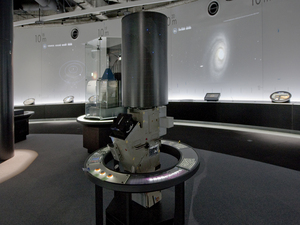Nagoya City Science Museum
TOP > Exhibition Guide > Keyword Search > Starting with "E" > experience > Spectroscopic Observation
Spectroscopic Observation



Purpose of Exhibition
You look up at any celestial body, and from which the “light” enters your eyes; correctly, it is a mixture of lights of various colors. The characteristics of each type of stars are strongly represented by what color of light it is composed of.
This process of dividing light into several colors (namely, dispersing) and examining which parts are bright or dark, is called Spectroscopic Observation. In spectroscopy, you can obtain a spectrum with many colors, not an image like astrophotography. From there, you can read various information of celestial bodies, such as the temperature and what elements are present.
In this exhibit we have a spectrometer that had been actually used for astronomical observations. Let’s disperse the starry light and see its spectrum.
Additional Knowledge
[Divide the Light]
When light enters a prism (or, a diffraction grating: same as follows), it gets split into its component colors. This is because light has some characteristics of waves: blue light has a shorter wavelength and so bends more as it passes through the prism, than red light. The different colors of light get bent at different angles, and thus spread out to form an effect similar to a rainbow (i.e. spectrum).
[Spectroscopic Observation]
You can observe spectra of celestial bodies by dividing their lights, as was said above, with some prism or other. From the dark lines in a spectrum, that is to say, colors absorbed by certain elements, you can determine the composition of a star. Also, the amount of light tells you the temperature, the pressure and the density of the star. So, you can classify stars by studying their spectra.
[How Does a Spectrometer Work?]
The spectrometer has a prism or a diffraction grating with a slit. The prism settings and the slit width determine the width of lines (i.e. resolution): Dark lines (absorption lines) and bright lines (emission lines) appearing in a spectrum. The narrower the slit, the narrower the spectral lines, allowing detailed observation. The Nikon spectrometer on display can distinguish wavelength differences of 1/10 nm or less in the red region.
[Spectral Classification and Spectral Types of Stars]
Stars can be classified according to the patterns of absorption lines in their spectra; Harvard scheme gives each star a capital letters O, B, A, F, G, K and M, in order from higher to lower surface temperature. Then the luminosity class is appended as a Roman numeral (I, II, III, IV, and V) according to the absolute brightness.
For example, Sirius has a surface temperature of about 10,000 degrees (A1 type), which is slightly higher than other stars, but has normal brightness belonging to the main sequence (V type). Consequently, its spectral type is classified as A1V type. The Sun is known as a G2V type star.
This page was last edited on 15 June 2022.
Article by Astronomy Section
